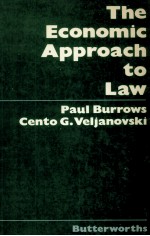

THE ECONOMIC APPROACH TO LAWPDF电子书下载
- 电子书积分:12 积分如何计算积分?
- 作 者:PAUL BURROWS
- 出 版 社:
- 出版年份:1981
- ISBN:
- 页数:343 页
1 Introduction: the economic approach to law&Paul Burrows and Cento G. Veljanovski 1
1.1 The economic approach to law 2
1.2 The benefits and costs of the economic approach 13
1.3 Positive economic theories of law—prediction v description 17
1.4 Toward an economic approach of the third kind 22
1.5 Statutory control 25
1.6 Concluding remarks 25
Part one Contract 35
2 Contract analysis: the transaction cost approach&Oliver E. Williamson 39
2.1 Economic approaches to contracting 39
2.2 A three-way classification of contracts 42
2.3 Transaction cost economics 45
2.4 Commercial contracting 48
2.5 Other applications 55
2.6 Concluding remarks 56
3 Economic analysis of contractual relations&Ian R. Macneil 61
3.1 Neoclassical microeconomic model, transactions costs and relational contract 62
3.2 Discrete transactions and modern contractual relations 64
3.3 Neoclassical microeconomic analysis of contractual relations 75
3.4 Conclusion 85
4 Judicial control of standard form contracts&M.J. Trebilcock and D.N. Dewees 93
4.1 Introduction 93
4.2 Standard form contracts and monopoly 98
4.3 Standard form contracts and information asymmetries 104
4.4 Comparative institutional competence 116
Part two Tort 121
5 The economic theory of tort liability—toward a corrective justice approach&Cento G. Veljanovski 125
5.1 Introduction 125
5.2 The legal and economic objectives of tort liability 126
5.3 A corrective justice framework 133
5.4 Some applications 140
5.5 Conclusion 144
6 Nuisance, legal rules and decentralized decisions: a different view of the cathedral crypt&Paul Burrows 151
6.1 Introduction 151
6.2 Justice and efficiency defined 151
6.3 Tertiary costs, information and general deterrence 152
6.4 Criteria for selecting legal rules 154
6.5 Conclusion 163
7 Negligent misrepresentation: an economic reformulation&William Bishop 167
7.1 Introduction 167
7.2 Conventional debate 168
7.3 Information production and appropriability 170
7.4 Two party negligent misrepresentation: transaction costs and quality signalling 176
7.5 Three party negligent misrepresentation 180
7.6 Public authorities 183
7.7 Conclusion 184
Part three The judicial process 187
8 Economic aspects of legal procedure&Roger A. Bowles 191
8.1 Introduction 191
8.2 Analytical background 192
8.3 Procedural issues 197
8.4 Concluding remarks 207
9 Quantitative rules and judicial decision making&Anthony I. Ogus 210
9.1 Optimal precision of legal rules 210
9.2 Trends in judicial rulemaking 215
9.3 Conclusions 222
10 The plea bargain in England and America: a comparative institutional view&Richard P. Adelstein 226
10.1 Criminal price exaction and the development of procedure 226
10.2 The negotiated plea in the price exaction framework 229
10.3 External aspects of the price exaction procedure: moral cost considerations 237
10.4 A direction for further research 246
11 Judicial responses to exchange rate instability&Roger A. Bowles and Christopher J. Whelan 253
11.1 Introduction 253
11.2 The law before 1975 254
11.3 The law since 1975 256
11.4 Some difficulties 259
11.5 Behaviour of defendants 265
11.6 Conclusions 267
Part four Public law 273
12 Landlord-tenant relations law&Werner Z. Hirsch 277
12.1 Introduction 277
12.2 Habitability laws 278
12.3 Rent control laws 290
12.4 Just-cause eviction laws 295
12.5 Age discrimination laws 298
12.6 Conclusions 300
13 The law and economics of the misconduct rule of unemployment insurance&Paul T. Fenn 307
13.1 Introduction 307
13.2 The misconduct rule: objectives and interpretation 308
13.3 Dismissal for misconduct: optimizing behaviour where the law is given 312
13.4 Disqualification for unemployment benefit as a result of misconduct: some evidence 315
13.5 Conclusion 318
14 Tax avoidance&J. Feldman and J. A. Kay 320
14.1 Introduction 320
14.2 Origins of tax avoidance 321
14.3 Tax avoidance and the definition of income 323
14.4 Tax avoidance in practice 325
14.5 Is tax avoidance inevitable? 331
Index 334
- 《乔治 凯南与美国东亚政策》(美)保罗·希尔(Paul J. Heer)著 2020
- 《万物的历程》(英)保罗·帕森斯(Paul Parsons) 2019
- 《女性外阴整形术 概念、分类及手术技巧》陶俊责任编辑;黄金龙,陈晓东译;(美国)Christine A.Hamoni,Paul E.Banwell,Red Alinsod 2019
- 《旅行》(法)保罗·莫朗(Paul Morand)著 2019
- 《电子治理》(澳)保罗·亨曼(Paul Henman)著 2019
- 《批判性思维与创造性思维 第3版》(美)理查德·保罗(Richard Paul) 2019
- 《糖溪帮探险记 第一季 5 勇闯芝加哥》(美)保罗·哈钦斯(Paul Hutchens)著 2012
- 《数学速览 分分钟掌握的200个数学知识 全新修订版》胡玉婷责任编辑;方弦译;(英国)Paul Glendinning 2019
- 《哦!多么不可思议的发明与古怪科学》(澳)西蒙·托罗克(Simon Torok),(澳)保罗·霍尔普(Paul Holper)著;王萍译 2005
- 《克鲁曼观点:拼有感经济》(美)保杰·克鲁曼 (Paul Krugman)著;杨大庆译 2012
